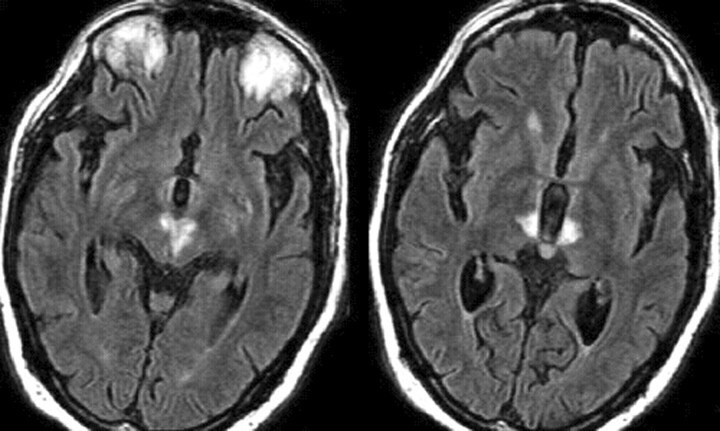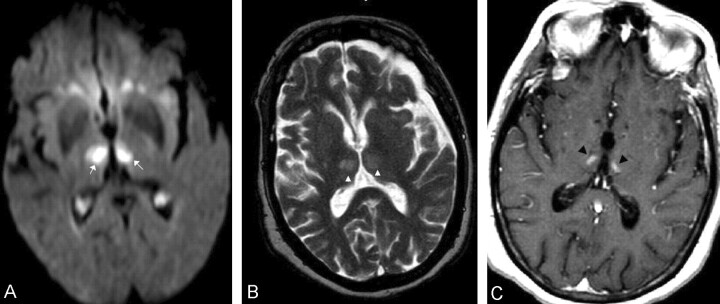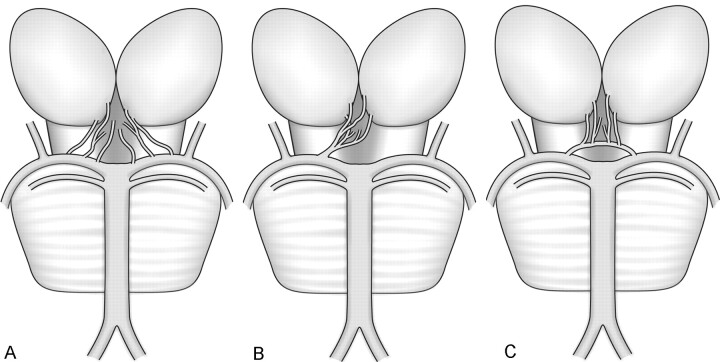Abstract
Summary: Thalami and midbrain arterial supply arises from many perforating blood vessels with a complex distribution for which many variations have been described. One rare variation, named the “artery of Percheron,” is a solitary arterial trunk that arises from one of the proximal segments of a posterior cerebral artery and supplies the paramedian thalami and the rostral midbrain bilaterally. Occlusion of this artery results in bilateral thalamic and mesencephalic infarctions. We describe three patients with a presumed occlusion of the artery of Percheron in whom MR imaging showed characteristic symmetrical bilateral paramedian thalamic and mesencephalic infarctions.
The thalami and the midbrain receive their blood supply from both the anterior (internal carotid arteries) and posterior (vertebro-basilar system) circulations, and several variations in this supply are known to exist (1, 2). The anterior circulation usually supplies the anteroinferior aspects of the thalami and midbrain with thalamoperforator arteries arising from the posterior communicating arteries. The posterior circulation usually supplies the medial aspects of the thalami and midbrain via branches arising from P1 segments and the lateral and superior aspects with branches arising from P2 segments of the posterior cerebral arteries (PCAs). Percheron studied the variations of this arterial supply and its distributions and described three different types of supply originating from P1 segments. In the second type described by Percheron, there is a common trunk arising from one of the P1 segments providing bilateral distribution. Occlusion of this trunk results in bilateral infarctions in the middle aspects of thalami and brain stem (3–7). We report the MR imaging findings in three patients who developed infarctions in the typical distribution of the artery of Percheron.
Case 1
A 68-year-old normotensive man was admitted to the emergency room with acute onset of decreased mental status. He had a history of hypertension, angina, hyperlipidemia, and episodic atrial flutter. Physical examination showed that he was unresponsive to voice commands and had no corneal reflexes, a constricted left pupil, and a fixed right pupil; the deep tendon reflexes were +3 and symmetric. These findings suggested a brain stem infarction, and CT performed 2 hours after the onset of symptoms showed no acute hemorrhage or infarctions. Owing to the patient’s lack of cooperation, an MR image could not be obtained until 48 hours after the onset of symptoms. The MR image showed symmetrical high signal intensity on fast spin-echo T2-weighted and fluid-attenuated inversion recovery (FLAIR) images bilaterally in rostral midbrain and paramedian thalami (Fig 1). Trace diffusion-weighted imaging showed corresponding high signal intensity, and restriction of water diffusion was confirmed on apparent diffusion coefficients (ADC) maps. During hospitalization, the patient recovered partially. One week after the onset of symptoms, he still had lethargy and mild memory deficit.
Fig 1.
Case 1. Axial FLAIR images (8500/110/2500/1 [TR/TE/TI/NEX]) show infarcts in the medial inferior thalami and extending into the medial and superior midbrain (territory of the artery of Percheron).
Case 2
A 50-year-old man, last seen awake 9 hours earlier, was found unresponsive in his house. On admission to a local hospital, he was unresponsive, hypertensive, and had a Glasgow coma scale score of 6. He had history of hypertension and hyperlipidemia. CT showed hemorrhage in the brain stem, and the patient was transferred to our hospital. On admission to our hospital, he was responsive to occasional verbal stimulus, and his pupils were 5 mm and nonreactive. In addition to the brain stem hemorrhage, MR imaging showed symmetric bilateral paramedian thalamic high signal intensity on fast spin-echo T2-weighted and FLAIR images (Fig 2). At the same level, trace diffusion-weighted images showed high signal intensity, and restricted diffusion was confirmed on ADC maps. The patient was extubated in the second day of hospitalization and developed tonic-clonic movements in all limbs. An electroencephalogram showed diffuse background slowing with intermittent rhythmic Δ that reflected a deep midline structural abnormality. The seizures were controlled with anticonvulsant medications, but he had not recovered his normal mental status 1 week after the infarction.
Fig 2.
Case 2. Axial T2-weighted images (5800/99/1 [TR/TE/NEX]) show areas of increased signal intensity in the paramedian thalamic and midbrain regions. Within the infarcts, there are hypointense areas suggesting the presence deoxyhemoglobin secondary to hemorrhages.
Case 3
A 77-year-old woman was admitted to the emergency room with a comminuted intertrochanteric fracture of the right hip after a motor vehicle collision. Physical examination showed that she was alert and oriented with no history of loss of consciousness or memory deficits. She had a history of hypertension, coronary artery disease with stent placement 6 years earlier, hypercholesterolemia, and obesity. The patient underwent arthroplasty on the day of admission, and 5 days after surgery she developed changes in her mental status manifested by altered levels of consciousness and drowsiness. MR imaging performed the next day showed bilateral and symmetrical areas of high signal intensity on fast spin-echo T2-weighted images and FLAIR images in rostral midbrain and in the paramedian thalami. Trace diffusion-weighted images showed corresponding high signal intensity (Fig 3), and restriction of water diffusion was confirmed on the ADC maps; no enhancement was seen in postcontrast spin-echo T1-weighted images.
Fig 3.
Case 3.
A, Axial trace diffusion-weighted image (5700/138 [TR/TE], b = 1000 s/mm2) obtained 24 hours after the onset of symptoms shows bilateral thalamic areas of high signal intensity (white arrows) compatible with that of acute paramedian thalamic infarcts.
B, Axial T2-weighted image (5800/99/1 [TR/TE/NEX]) shows rounded areas (arrowheads) of increased signal intensity in the medial thalami.
C, Axial T1-weighted (440/17/1 [TR/TE/NEX]) postcontrast image obtained 12 days after image in panel A shows contrast enhancement in the bilateral thalamic infarcts (black arrowheads).
Follow-up MR imaging performed 13 days after the ictus showed mild to moderate contrast enhancement in postcontrast spin-echo T1-weighted images in the infarcts (Fig 3). During her hospitalization, the patient partially recovered her normal mental status.
Discussion
The thalami contain strategic nuclei and integrate several important cortical functions. Thus, infarcts at the mesencephalic-diencephalic junctions may result in complex clinical syndromes, with patients exhibiting a wide range of symptoms varying from motor deficits to behavioral and sensory alterations. The clinical patterns and their anatomic correlates are well described in several previous studies (4–7). Our patients presented with different symptoms, all of them described as part of the paramedian thalamic syndrome. In this syndrome, the prominent changes in mental status may be due to involvement of the reticular activating system. The ocular abnormal reflexes described in two of our patients (cases 1 and 2) may have been due to involvement of the midbrain at the level of the Edinger-Westphal nucleus.
The mesencephalic-diencephalic junction arterial supply defines the size and location of the ischemic damage. Perforating arteries arising from both P1 segments of the PCA supply predominantly the hypothalamus, medial ventral thalami, and subthalamic-mesencephalic junctions. Most of the perforating branches from the P1 segments have an ipisilateral distribution (78%); bilateral or even contralateral distributions may be observed in 22% of individuals (2). Percheron described three possible variations involving the paramedian thalamic-mesencephalic arterial supply: small branches arising from both P1 segments, an asymmetrical common trunk arising from a P1 segment (this variation is called the artery of Percheron), or an arterial arcade emanating from an artery bridging the two P1 segments (Fig 4).
Fig 4.
Variations of the paramedian thalamic-mesencephalic arterial supply according to Percheron.
A, In the most common variation, there are many small perforating arteries arising from the P1 segments of the PCA.
B, The artery of Percheron is a single perforating blood vessel arising from one P1 segment.
C, The third type of variation is that of an arcade of perforating branches arising from an artery bridging the P1 segments of both PCAs.
Bilateral thalamic infarcts are uncommon. The paramedian thalamic region is the most commonly affected location, and usually the infarcts are asymmetrical and caused by multiple emboli or small artery disease. Occlusion of the artery of Percheron results in bilateral medial thalamic and rostral mesencephalic infarctions with a relatively symmetrical distribution. Castaigne et al (6) stated that, when the artery of Percheron is occluded, the thalamic infarcts are always bilateral and medial.
Conclusion
In the three cases reported here, conventional MR imaging and the diffusion-weighted imaging confirmed the presence of the infarctions. All three of the patients demonstrated similar symmetric thalamic and mesencephalic lesions typically seen in occlusion of the artery of Percheron (8).
From a practical standpoint, these infarcts should be recognized as due to occlusion of a possible single rare artery that is a normal anatomic variant showing its peculiar supply and not be blamed on occlusion of multiple vascular territories or other pathologic conditions such vasculitis or infectious disease. Supratentorial bilateral symmetrical arterial distributions are unusual. An azygous anterior cerebral artery occlusion may result in bilateral infarctions. When bilateral medial thalamic infarcts are encountered, the differential diagnosis also includes the “top of the basilar artery” syndrome. In this latter entity, infarctions tend to involve also the territories supplied by the superior cerebellar and PCAs. We propose that, when bilateral medial thalamic infarcts are found, occlusion of the artery of Percheron should be considered as the main diagnosis. Performing conventional angiography may not be indicated, because lack of visualization of the artery does not exclude its presence (because it is occluded).
References
- 1.Percheron G. The anatomy of the arterial supply of the human thalamus and its use for the interpretation of the thalamic vascular pathology. Z Neurol 1973;205:1–13 [DOI] [PubMed] [Google Scholar]
- 2.Lasjaunias P, Berenstein A, Brugge KGT, eds. Surgical Neuroangiography. 2nd ed. Berlin: Springer-Verlag;2000. ,Vol. 1:526–562 [Google Scholar]
- 3.Roitberg BZ, Tuccar E, Alp MS. Bilateral paramedian thalamic infarct in the presence of an unpaired thalamic perforating artery. Acta Neurochir 2002;144:301–304 [DOI] [PubMed] [Google Scholar]
- 4.Lepore FD, Gulli V, Miller DC. Neuro-ophthalmological findings with neuropathological correlation in bilateral thalamic-mesencephalic infarction. J Clin Neuro-ophthalmol 1985;5:224–228 [PubMed] [Google Scholar]
- 5.Kumral E, Evyapan D, Balkir K, et al. Bilateral thalamic infarction, clinical etiological and MRI correlates. Acta Neurol Scand 2001;103:35–42 [DOI] [PubMed] [Google Scholar]
- 6.Castaigne P, Lhermitte F, Buge A, et al. Paramedian thalamic and midbrain infarcts: clinical and neuropathological study. Ann Neurol 1985;10:127–148 [DOI] [PubMed] [Google Scholar]
- 7.Biller J, Sand JJ, Corbett JJ, et al. Syndrome of the paramedian thalamic arteries: clinical and neuroimaging correlation. Clin Neuro-ophthalmol 1985;5:217–223 [PubMed] [Google Scholar]
- 8.Kuker W, Weise J, Krapf H, et al. MRI characteristics in acute and subacute brainstem and thalamic infarctions: values of T2- and diffusion-weighted sequences. J Neurol 2002;249:33–42 [DOI] [PubMed] [Google Scholar]






